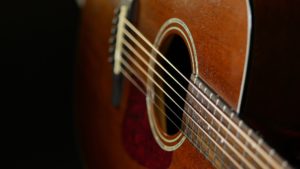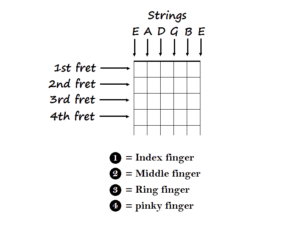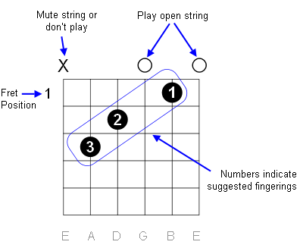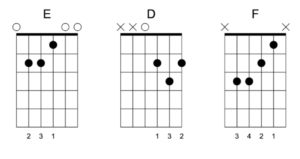
Introduction
How To Read Guitar Chords
Learning how to read guitar chords is among the most important steps in playing the guitar. Guitar chords are a visual graphic representation of how you position the fingers of your left hand on the strings on the fret. The combination of your 4 fingers allows you to play notes depending on what open string that you play with your pick on the right hand. Below is a visual graph of the fundamentals of guitar chords.( https://en.wikipedia.org/wiki/Minor_chord)

1.How to remember the notes of the guitar strings
Here’s two useful mnemonics to help you remember the order “E, A, D, G, B, E”.
- Elephants And Donkeys Grow Big Ears
- Eddie Ate Dynamite Good Bye Eddie
You can pick whatever mnemonics that you like the best
When you are holding the guitar using the proper posture position you are ready to play. When you play you will hit the Low E string which is closest. When you strum downward with your right hand, you will hit the A,D, G,B and the last string the high E
2.Finger Placement
Understanding guitar chords is the most difficult part of learning how to play guitar. The above mentioned chart is a visual graphic of where to place your left finger when playing the guitar

Chord Fingering:
- 1 = Index Finger
- 2 = Middle Finger
- 3 = Ring Finger
- 4 = Little Finger (Pinky)
- T = Thumb
The horizontal line at the top of the guitar is the nut of the guitar where the head meets the fingerboard. Each subsequent horizontal line below it are frets.The six vertical lines represent a string, from left to right E, A, D, G, B, E or using mnemonics Elephants And Donkeys Grow Big Ears.
When you are holding the guitar using the proper posture position you are ready to play. When you play you will hit the Low E string which is closest. When you strum downward with your right hand, you will hit the A,D, G,B and the last string the high E
The diagram above you will see three black dots which indicates that you will need to press down on three strings. They are the A, D and B string between the first and second fret. The numbers at the bottom of the chart tells you which fingers on your left hand that you need to use to hold down the strings. Your left hand fingers are numbered one through 4 starting with your index finger.
Putting it together! Place your middle finger on the second fret of the D string, your ring finger on the third fret of the A string and your index finger on the first fret of the B string. Always use the tips of your finger so you don’t mute any strings. Play the open strings from the G and E .Strum slowly from A string down one note at a time, make sure that you are fretting each note clearly. Congratulations you just played a C Chord. If you placed the little finger (4) on the third fret of the G cord, they you just played the C7 chord(https://takelessons.com/live/guitar/finger-placement-guitar-chords)
3)Essential Chords
Learn Your Essential Chords-You MUST..MUST learn the following chords C,A, G, E, D, F, Am, Dm and Em. The first six are your basic chords followed with the remaining 3 minor chords. Most of the chords are not difficult to learn because their left finger positions are close together. The hardest one to learn is the F and the minor chords. You can combine these chords together to build a simple song which will help your memory.



4)Learn Different Chords-If you are given or purchase the Chord Progression Chart they are ranked as group I, IV, V, I. They can be heard in a lot of of today’s popular music. Each progression can be played in any key, which allows for endless combinations and sounds. You have your three principal, 3 minor and additional chords and you can combine them to play music varying from pop, rock and blues.

5)Build Your Own Reference Library
When you are trying to learn chords you may have to invest in books and reference materials. First, its important to consult your guitar instructor for the best recommended guides. Second look for books that teach beginning guitar students essential chords and how to combine them in to basic songs. Third, pick up the Guitar Progressions Chart to learn the minor and additional chords and maybe a chord dictionary. Fourth, check out the internet for websites that have developed different approaches in teaching chords. This will help you build a library of reference materials.
6. Make Sure You Are Practicing Correctly
If you want to learn your chords properly then you have to practice them in order to sound them correctly. The best way to do this is to play each string in the chord one at a time and listen for muffled sound. If you hear an incorrect note you can adjust your fingers to fix it. Remember it is important to push the fingertip straight into the fretboard whenever possible to prevent accidentally muting strings adjacent to those intended. You can always move your thumb further down the back of the neck to help your fingers more easily hold down the upper strings at the proper angles.(source: https://takelessons.com/blog/10-tips-to-learn-guitar-chords-z01)
7)Strumming Without A Pick

A valuable technique that you can develop as a beginning guitar student is the ability to play without a pick. Guitar legends in the rock and roll music world have developed legendary techniques on the guitar without a standard flatpick.
When it comes to strumming the guitar there is no right or wrong approach, it’s just that there are a lot of techniques and find one that works for you and produce the sound that you want. The techniques are based on personal styles of famous guitar players, or better yet a rhythm style.
Technique #1- Strum With Your Thumb
One of the best ways to start playing without a pick is strumming with your thumb. First, you have to get the angle of your thumb right. Second, you have to try to keep your thumb parallel to the strings and try to come in at a slight angle. The goal is to make sure that your finger does not get caught on any of the strings. This technique will take some time to master until it becomes automatic.
Technique # 2-Strum With Your Index Finger
The second approach switches from your thumb to the index finger. First you strum the downstroke with your nail and upstroke with your finger. This technique will take some time to master until it becomes automatic.
Technique #3-Strum with Your Thumb and Index Finger.
In the third approach you combine techniques 1&2 and it sort of in reverse. Now you play the downstroke with your thumb and upstroke with your index finger. The aim is to create a sound that does not come from a pick and that is more balanced.
Technique #4-Holding Your Fingers Together Like a Pick
This technique require you to put your thumb and index fingers together similar to holding a pick. Next you need to create an X pattern by extending your thumb a bit beyond the index finger. Your index fingernail plays the down stroke while the thumbnail covers the upstroke. The goal is to create a sound as if you are using a pick to create a brighter sound.
Technique #5- Adding Bass Notes including a Backbeat
A common approach used in popular, country and folk music songs is to combine bass notes with strumming. The strumming is done with the index finger playing the down and upstrokes. Also, on beats 2 and 4 there is a slight accent. This is done by lightly dropping the finger-picking hand on the strings, which causes the strings to be pushed down and hit the frets on the fingerboard. This percussive slap creates a cool backbeat groove(source: https://www.premierguitar.com/5-ways-to-strum-without-a-pick)
In conclusion strumming without a pick is an important skill to learn as a beginning guitar student as well as intermediate and advanced level players. Guitar legends in the rock and roll music world have developed legendary techniques on the guitar without a standard flatpick. When it comes to strumming the guitar there is no right or wrong approach, it’s just that there are a lot of techniques and find one that works for you and produce the sound that you want.
The 5 above mentioned techniques will help you learn how to strum your guitar better and will allow you make different kinds of sound or tones when playing songs.
8) Find Music That Interest You- To help you learn more than the basic chords choosing songs that have some level of difficulty will force you to stretch your ability to play them.
9) Learn Music Theory– It is important to remember that learning chords will help you understand music theory. It is not required in music school and private instructors in guitar training, but learning music theory will help you become a professional musician and to compose songs for individual and commercial use
10) Find a Good Teacher– Finding a good teacher is not as hard as you think because you can ask friends and family if they know someone who runs a music school locally in your town, city or metropolitan area. Secondly, there are a lot of experts on the internet from around the world that run guitar training website/membership portals where you can sign up and get courses free or pay for advanced training. Millions of people are learning how to play online from world class instructors via video on YouTube or video conferencing using Zoom. Ultimately you have to choose an instructor whether local or online that you are comfortable with.